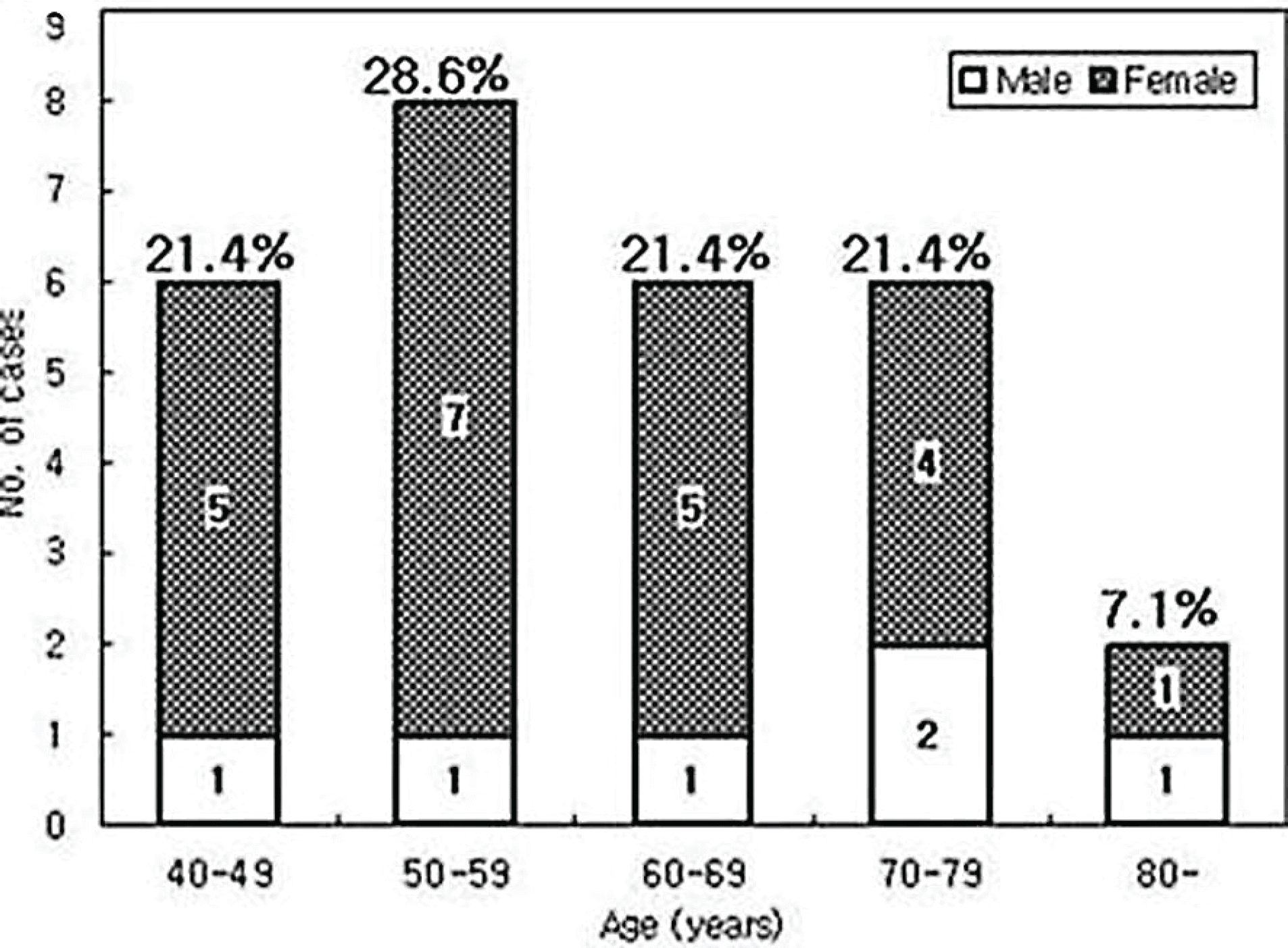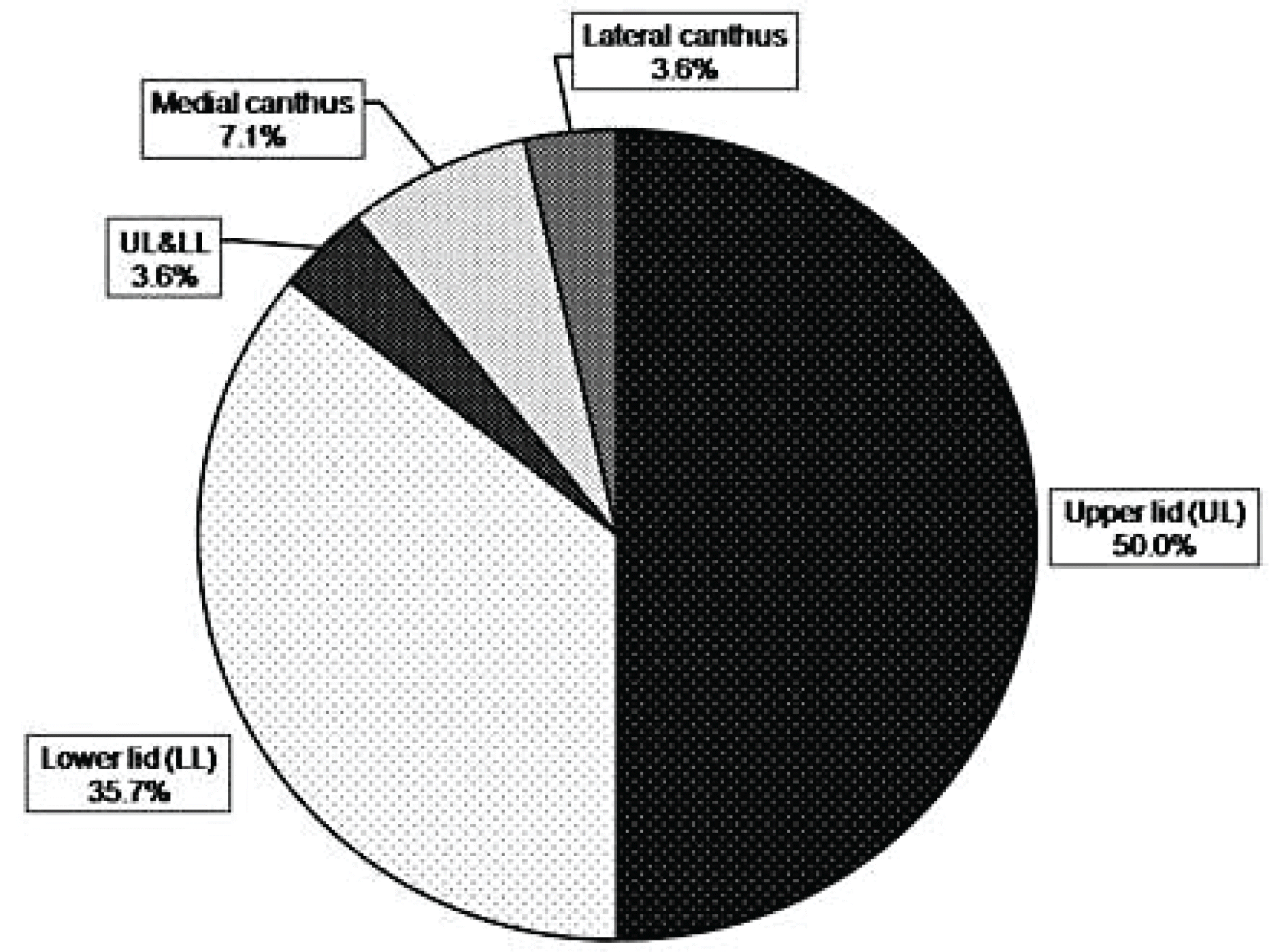Abstract
Purpose
To investigate the clinical features and treatment results in eyelid sebaceous gland carcinoma.
Methods
A retrospective chart review was conducted on 28 adult patients that were histopathologically diagnosed with eyelid sebaceous gland carcinomas from April 1981 to March 2005 in Seoul National University Hospital.
Results
Among the 28 cases of eyelid sebaceous gland carcinoma, 9 cases (32.1%) had evidences of local invasion or metastasis at the initial diagnosis. Surgical resection was performed in the 27 cases (96.4%), and conjunctival cryotherapy, surgeries, such as maxillectomy, parotidectomy, and neck dissection, or radiation therapy were combined in cases of local invasion or metastasis. In the 19 cases of the localized tumor group, there were 2 cases (10.5%) of recurrence after an average 30 months of follow-up. The locally invasive tumor group (2 cases) showed 1 case of recurrence after 12 months of follow-up. In the 7 cases of the distant metastasis tumor group, tumors in 3 cases (42.9%) could not be controlled, and 3 cases (75.0%) showed recurrence after an average 45 months of follow-up.
Conclusions
Eyelid sebaceous gland carcinomas with local invasion or metastasis afford higher potential for treatment failure, so early diagnosis is crucial. Because recurrence is possible, even when the tumor is completely removed, the extent of the tumor should be examined thoroughly and microscopically.
Go to : 
References
1. Lee HK, Hu CH, Kang SJ, Lee SY. Clinical analysis of lid tumors. J Korean Ophthalmol Soc. 1997; 38:1892–8.
2. Allali J, D'Hermies F, Renard G. Basal cell carcinomas of the eyelids. Ophthalmologica. 2005; 219:57–71.

3. Cook BE, Bartley GB. Epidemiologic characteristics and clinical course of patients with malignant eyelid tumors in an incidence cohort in Olmsted County, Minnesota. Ophthalmology. 1999; 106:746–50.

4. Kim HY. Eyelid tumor. Lee SY, Kim YD, Khwarg SI, Kim SJ, editors. Ophthalmic Plastic and Reconstructive Surgery. 1st ed.Seoul: Naewae Haksool;2004. chap 11.
5. Lee SB, Saw SM, Au Eong KG, et al. Incidence of eyelid cancers in Singapore from 1968 to 1995. Br J Ophthalmol. 1999; 83:595–7.
7. Lee TS, Lee JJ. Analysis of classification and incidence of eyelid and orbital tumors. J Korean Ophthalmol Soc. 1997; 38:1700–5.
8. Shields JA, Demirci H, Marr BP, Eagle RC Jr. Sebaceous carcinoma of the ocular region. Surv Ophthlmol. 2005; 50:103–22.
9. Shields JA, Demirci H, Marr BP, et al. Sebaceous carcinomas of the eyelids. Ophthalmology. 2004; 111:2151–7.
10. Cook BE, Bartley GB. Treatment options and future prospects for the management of eyelid malignancies: an evidence-based update. Ophthalmology. 2001; 108:2088–98.

11. Park JW, Chung WS. Classification and therapeutic experiences of orbital tumors. J Korean Ophthalmic Soc. 1997; 38:1315–21.
12. Folberg R, Whitaker DC, Tse DT, Nerad JA. Recurrent and residual carcinoma after Mohs' excision of the primary lesion. Am J Ophthalmol. 1987; 103:817–23.
13. Putterman AM. Conjunctival map biopsy to determine pagetoid spread. Am J Ophthalmol. 1986; 102:87–90.

14. Lisman RD, Jakobiec FA, Small P. Sebaceous carcinoma of the eyelids. The role of adjunctive cryotherapy in the management of conjunctival pagetoid spread. Ophthalmology. 1989; 96:1021–6.
15. Esmaeli B. Sentinel node biopsy as a tool for accurate staging of eyelid and conjunctival malignancies. Curr Opin Ophthalmol. 2002; 13:317–23.

16. Park CS, Son JH, Chung WS, Cho IH. Lymphoscintigraphy of eyeball and ocular adnexal malignant tumors. J Korean Ophthalmol Soc. 2004; 45:893–8.
18. Nunrey WR, Welsh MG, McCord CD Jr. Recurrence of sebaceous carcinoma of the eyelid after radiation therapy[case report]. Am J Ophthalmol. 1983; 96:10–5.
19. Guthrie TH Jr, McElveen LJ, Porubsky ES, Harmon JD. Cisplatin and doxorubicin; an effective chemotherapy combination in the treatment of advanced basal cell and squamous carcinoma of the skin. Cancer. 1985; 55:1629–32.

20. Lippman SM, Shimm DS, Meyskens FL Jr. Nonsurgical treatments for skin cancer: retinoids and alpha-interferon. J Dermatol Surg Oncol. 1988; 14:862–9.
Go to : 
Table 1.
Classification and symptom duration of sebaceous gland carcinoma (SGC)
| Tumor group | Localized group | Locally invasive group | Distant metastasis group | Total |
|---|---|---|---|---|
| Nodular form group | 14 (20)* | 2 (26) | 4 (14) | 20 (19) |
| Diffuse form group | 5 (30) | 0 | 3 (64) | 8 (43) |
| Total | 19 (23) | 2 (26) | 7 (35) | 28 (26) |
Table 2.
Treatment of sebaceous gland carcinoma (SGC)
| Group | Case No. | Treatment method | Follow up* | Result | recurrence Treatment at | Final result | |
|---|---|---|---|---|---|---|---|
| Localized group | Nodular form | 1 | Excision only | 6 | Recur (−) | (−) | Alive & well |
| 2 | Excision only | 57 | Recur (−) | (−) | Alive & well | ||
| 3 | Excision only | 42 | Recur (−) | (−) | Alive & well | ||
| 4 | Excision only | 72 | Recur (−) | (−) | Alive & well | ||
| 5 | Excision only | 40 | Recur (−) | (−) | Alive & well | ||
| 6 | Excision only | 46 | Recur (−) | (−) | Alive & well | ||
| 7 | Excision only | 34 | Recur (−) | (−) | Alive & well | ||
| 8 | Excision only | 12 | Recur (−) | (−) | Alive & well | ||
| 9 | Excision only | 7 | Recur (−) | (−) | Alive & well | ||
| 10 | Excision only | 2 | Recur (−) | (−) | Alive & well | ||
| 11 | Excision only | 40 | Recur (−) | (−) | Alive & well | ||
| 12 | Excision only | 6 | Recur (−) | (−) | Alive & well | ||
| 13 | Excision only | 51 (38) | Recurred | Parotidectomy MRND | Alive & well | ||
| 14 | Excision only | 108 (36) | Recurred | Excision | Dead (other causes) | ||
| Diffuse form | 15 | Excision only | 36 | Recur (−) | (−) | Alive & well | |
| 16 | Excision only | 50 | Recur (−) | (−) | Alive & well | ||
| 17 | Excision only | 24 | Recur (−) | (−) | Alive & well | ||
| 18 | Excision only | 6 | Recur (−) | (−) | Dead (other causes) | ||
| 19 | Excision only | 8 | Recur (−) | (−) | Dead (other causes) | ||
| Locally invasive group | Nodular form | 20 | Excision & cryotherapy | 24 (12) | Recurred | Excision | Alive & well |
| 21 | Exenteration & maxillectomy | 6 | Recur (−) | (−) | Alive & well | ||
| Distant metastasis group | Nodular form | 22 | Excision, cryo, parotidectmy, neck RT† | 36 (24) | Recurred | Parotidectomy | Alive & well |
| 23 | Excision & neck RT | 147 (96) | Recurred | Neck RT | Dead due to SGC | ||
| 24 | Exenteration | 12 | Fail | (−) | Dead due to SGC | ||
| 25 | Radiation only | 25 | Fail | (−) | Dead due to SGC | ||
| Diffuse form | 26 | Excision, cryo, MRND, neck RT | 39 | Recur (−) | (−) | Alive & well | |
| 27 | Exenteration, maxillectomy, MRND‡ | 44 (22) | Recurred | Maxillectomy | Alive with meta | ||
| 28 | Exenteration, parotidectomy, neck RT, chemo | o 14 | Fail | (−) | Dead due to SGC | ||




 PDF
PDF ePub
ePub Citation
Citation Print
Print




 XML Download
XML Download